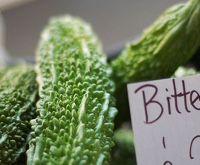 Most cities have local ethnic food stores that sell produce for a lot less than the big grocery chains. I suppose they are called this because they are often started by immigrants to serve other immigrants (ex. Mexican, Vietnamese, Armenian). But why are they cheaper? One popular theory was that they bought the “ugly” stuff that the chains wouldn’t buy. (Driscoll’s became dominant by breeding beautiful strawberries, even though in my opinion it tastes like they crossbred with styrofoam.)
Most cities have local ethnic food stores that sell produce for a lot less than the big grocery chains. I suppose they are called this because they are often started by immigrants to serve other immigrants (ex. Mexican, Vietnamese, Armenian). But why are they cheaper? One popular theory was that they bought the “ugly” stuff that the chains wouldn’t buy. (Driscoll’s became dominant by breeding beautiful strawberries, even though in my opinion it tastes like they crossbred with styrofoam.)
In the case of New York City Chinatown at least, the WSJ found (non-paywall link) that a major reason behind the lower prices are special, local supply chains.
Her discovery: Chinatown’s 80-plus produce markets are cheap because they are connected to a web of small farms and wholesalers that operate independently of the network supplying most mainstream supermarkets.
My personal theory is that these are family businesses and everyone pitches in. The article doesn’t directly address cheap family labor, but minimal overhead is discussed:
Indeed, Chinatown’s green grocers make Costco look like Dean & DeLuca. Some are mere sidewalk stands renting space in front of a nail salon or a drugstore. Shelves are typically made of plywood and lined with newsprint; prices are hastily marked on strips of cardboard. Shoeboxes serve as cash registers. The scales are still analogue, and good luck using a credit card.
All this translates into low overhead for the retailers—and low prices for shoppers. The typical Chinatown produce markup is just 10% to 12% over wholesale, said Wellington Chen, executive director of the Chinatown Partnership Local Development Corp.
This special sourcing can vary. Unfortunately I don’t live near NYC Chinatown, but in my local ethnic market, some of the produce will also be from a local farm, often the lesser-known asian vegetable or herbs that grow like weeds but wilt quickly. However, some of these vendors also offer everything from watermelon to tomatoes in December. In that case, then they are probably buying some things directly from a commercial wholesaler. (It still might be cheaper than a chain.) I usually look for a sign that says “local” or simply ask them what is locally grown.
 The Best Credit Card Bonus Offers – 2025
The Best Credit Card Bonus Offers – 2025 Big List of Free Stocks from Brokerage Apps
Big List of Free Stocks from Brokerage Apps Best Interest Rates on Cash - 2025
Best Interest Rates on Cash - 2025 Free Credit Scores x 3 + Free Credit Monitoring
Free Credit Scores x 3 + Free Credit Monitoring Best No Fee 0% APR Balance Transfer Offers
Best No Fee 0% APR Balance Transfer Offers Little-Known Cellular Data Plans That Can Save Big Money
Little-Known Cellular Data Plans That Can Save Big Money How To Haggle Your Cable or Direct TV Bill
How To Haggle Your Cable or Direct TV Bill Big List of Free Consumer Data Reports (Credit, Rent, Work)
Big List of Free Consumer Data Reports (Credit, Rent, Work)
I have been pondering why our local produce shop has both the best prices and the best quality produce. I should do a bit more sleuthing when I shop during their morning deliveries. Their prices are easily 50-60% cheaper than the supermarket and the quality is almost always far superior. When it’s not, it might be the same quality but still much better prices. Sprouts is the only chain that seems to come close to price and maybe quality. Has Sprouts come out to your area yet?
Most smaller places that I’ve asked are pretty open about where the stuff comes from. They are proud of the stuff they (or their family) grows, and the rest they admit they buy in bulk and portion out. It makes sense, if I buy a dark green then I’m likely going to want garlic too, whether you grow it or not.
I don’t have a Sprouts but have been to one. I thought they got merged with another big chain but I was thinking of Wild Oats.
Non-paywall WSJ link: http://online.wsj.com/public/resources/documents/print/WSJ_-A016-20160625.pdf
Good post. Here in Philadelphia, the Chinatown and Italian Market both have amazing produce prices. I’m still trying to find something similar in the suburbs. One shop nearby, that always seemed empty, just closed. Everyone around here seems to go to the big chains.
Thanks for the non-paywall link. May I ask if there was a trick to how you found that? I recently paid for a WSJ subscription but I am having trouble sharing articles due to the paywall.
If you Google the WSJ article title, the non-paywall link is the 2nd result. That used to be the trick to get around the paywall, but they mostly closed the loophole at least for newer articles.
Its the same case with my local indian store. The basics are much cheaper and I would always wonder why they were much cheaper.
You guys eat Bitter Melon/Bitter Gourd? 🙂
Yup, love it with black bean sauce and garlic. I’m the only one in the family that does though…
By the way bitter melon juice ( one shown in the picture) is proven to help BP and Sugar patients. Try it if you would like, its better than many prescriptions.
I always worried that ethnic grocery stores (which we love) had some gray or black market angle to their super low prices – nice to know it’s something more tame! And I’ll quit joking that they must have hijacked a truck (Goodfellas style) from another grocery store.